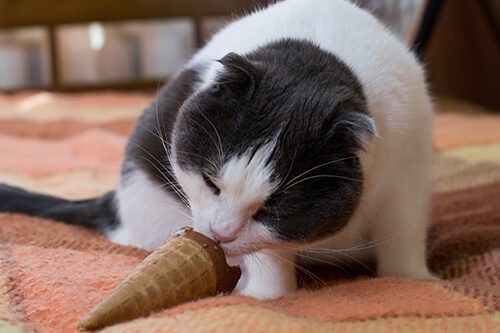The Danger of Chocolate to Cats
Chocolate contains two main harmful components for cats: theobromine and caffeine. Both of these are types of stimulants that affect the central nervous system and the cardiac muscle. Here’s a closer look at why these are problematic for cats:
- Theobromine and Caffeine Metabolism: Cats have a much slower metabolism for theobromine and caffeine compared to humans. This slow processing means that even small amounts of these substances can accumulate to toxic levels in their bodies.
- Nervous System Effects: The stimulant effect of theobromine and caffeine can lead to hyperactivity, tremors, and seizures in cats. These symptoms occur because the cat’s nervous system becomes overstimulated, which can be dangerous and potentially life-threatening.
- Cardiac Effects: These substances can also increase heart rate and may lead to abnormal heart rhythms (arrhythmias). In severe cases, this can cause heart failure.
- Gastrointestinal Upset: Chocolate can cause vomiting and diarrhea in cats. These symptoms might seem mild but can lead to dehydration and electrolyte imbalances, complicating the cat’s condition.
Signs of Chocolate Poisoning in Cats
Recognizing the signs of chocolate poisoning early can be crucial for your cat’s health. Look out for:
- Vomiting or diarrhea
- Restlessness or hyperactivity
- Rapid breathing
- Increased heart rate
- Muscle tremors or seizures
These symptoms can vary in severity depending on the amount and type of chocolate ingested. Darker chocolates and products with high concentrations of cocoa are more dangerous because they contain higher levels of theobromine and caffeine.
Preventing Chocolate Poisoning in Cats
Prevention is key when it comes to protecting your cat from the dangers of chocolate. Here are some strategies:
- Secure Storage: Always keep chocolate and chocolate products in secure locations that your cat cannot access. Remember that cats can be quite agile and curious, so it’s best to err on the side of caution.
- Educate Everyone: Make sure all family members and visitors know not to feed chocolate to your cat. Children, in particular, may not understand the risks and could share their treats with pets.
- Be Vigilant During Holidays: Times of celebration, such as Christmas, Easter, and Halloween, often bring more chocolate into the home. Be extra cautious during these periods to ensure chocolates are not left within reach of your cat.
When to Call Limerick Veterinary Hospital or Your Nearest Emergency Vet
If you even suspect that your cat has ingested chocolate, it’s important to act quickly. Contact Limerick Veterinary Hospital or the nearest emergency veterinary service immediately. Quick action can greatly improve the prognosis for your cat.
Understanding these risks and taking steps to prevent your cat from coming into contact with chocolate can help ensure they stay healthy and safe. Should you need advice or if an incident occurs, Limerick Veterinary Hospital is here to help. Don’t hesitate to reach out to us at (610) 489-2848 for any concerns regarding your cat’s health.

